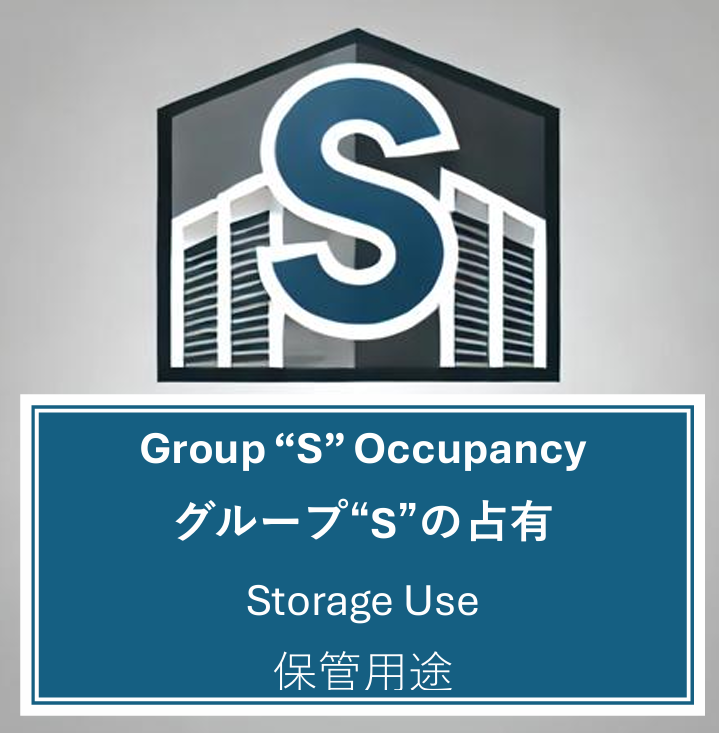
General Definition
- Storage Group “S” Occupancy under the International Building Code (IBC) refers to buildings or portions of buildings used for storing goods, materials, or products, with considerations for fire risks, access requirements, and hazardous materials regulations.
- In Japan’s Building Standards Law (BSL), storage facilities are classified under 倉庫 (Sōko) – Warehouses/Storage Buildings, with additional regulations depending on hazardous material content. These buildings are subject to:
- 建築基準法 (Kenchiku Kijun-hō) – Building Standards Law (BSL) (for structural and zoning compliance)
- 消防法 (Shōbō-hō) – Fire Service Act (for fire safety and hazardous material regulations)
- 危険物取扱法 (Kikenbutsu Toriatsukai-hō) – Hazardous Materials Control Act (for specific hazardous materials in storage)
- Both the International Building Code (IBC) and Japan’s Building Standard Law (BSL) classify storage buildings based on fire hazard levels, storage type, and building size.
- However, BSL enforces stricter seismic stability and zoning regulations, especially for large warehouses and hazardous storage facilities.
IBC Moderate-hazard storage, Group S-1 Occupancy
- Aerosol products, Levels 2 and 3
- Aircraft hangar (storage and repair)
- Bags: cloth, burlap and paper
- Bamboos and rattan
- Baskets
- Belting: canvas and leather
- Books and paper in rolls or packs
- Boots and shoes
- Buttons, including cloth covered, pearl or bone
- Cardboard and cardboard boxes
- Clothing, woolen wearing apparel
- Cordage
- Dry boat storage (indoor)
- Furniture Furs Glues, mucilage, pastes and size
- Grains
- Furniture
- Horns and combs, other than celluloid
- Leather
- Linoleum
- Lumber
- Motor vehicle repair garages complying with the maximum allowable quantities of hazardous materials listed in Table 307.1(1) (see Section 406.8)
- Photo engravings
- Resilient flooring
- Self-service storage facility (mini-storage)Silks
- Soaps
- Sugar
- Tires, bulk storage
- Tobacco, cigars, cigarettes and snuff
- Upholstery and mattresses
- Wax candles
BSL Occupancies Corresponding to IBC Group S-1
- 倉庫 (Sōko) – General Warehouses
- 物流センター (Butsuryū Sentā) – Distribution Centers
- 自動車部品倉庫 (Jidōsha Buhin Sōko) – Automotive Parts Storage
- 書類保管庫 (Shorui Hokan-ko) – Document Archives / Paper Storage
- 木材倉庫 (Mokuzai Sōko) – Lumber & Wood Storage Facilities
Click the button below to access the applicable codes guidelines
IBC Low-hazard storage, Group S-2 Occupancy
- Asbestos
- Beverages up to and including 16-percent alcohol in metal, glass or ceramic containers
- Cement in bags
- Chalk and crayons
- Dairy products in nonwaxed coated paper containers
- Dry cell batteries
- Electrical coils
- Electrical motors
- Empty cans
- Food products
- Foods in noncombustible containers
- Fresh fruits and vegetables in nonplastic trays or containers
- Frozen foods
- Glass
- Glass bottles, empty or filled with noncombustible liquids
- Gypsum board Inert pigments Ivory
- Meats
- Metal cabinets
- Metal desks with plastic tops and trim
- Metal parts
- Metals
- Mirrors
- Oil-filled and other types of distribution transformers
- Parking garages, open or enclosed Porcelain and pottery
- Stoves
- Talc and soapstones
- Washers and dryers
BSL Occupancies Corresponding to IBC Group S-2
- 倉庫 (Sōko) – General Warehouses for Non-Combustible Materials
- 冷蔵倉庫 (Reizō Sōko) – Refrigerated Storage Facilities
- 立体駐車場 (Rittai Chūshajō) – Enclosed Parking Garages
- 駐輪場 (Chūrinjō) – Bicycle Storage Facilities
- 保管庫 (Hokanko) – Secure Storage for Valuables (Banks, Museums, Government Records)
Click the button below to access applicable codes guidelines
Key Differences
- BSL does not use an S-1 or S-2 classification but instead separates storage by material type (general, hazardous, cold storage, and vehicle storage).
- BSL enforces stricter fireproofing (耐火建築物) for large warehouses and requires designated storage districts for hazardous materials.
- Seismic stability and zoning controls are stricter in BSL for large-scale logistics centers and fuel storage depots.
